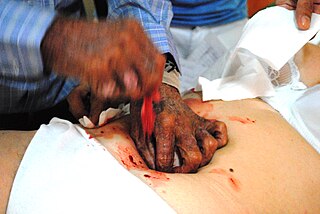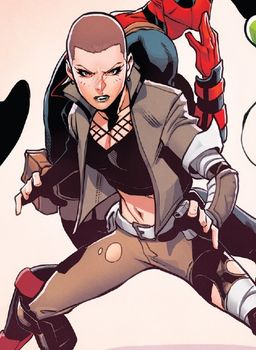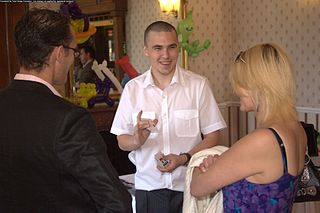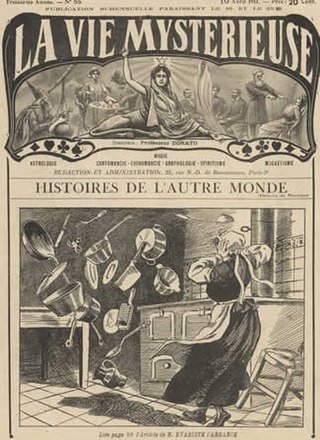Related Research Articles

Telepathy is the purported vicarious transmission of information from one person's mind to another's without using any known human sensory channels or physical interaction. The term was first coined in 1882 by the classical scholar Frederic W. H. Myers, a founder of the Society for Psychical Research (SPR), and has remained more popular than the earlier expression thought-transference.

Psychic surgery is a pseudoscientific medical fraud in which practitioners create the illusion of performing surgery with their bare hands and use sleight of hand, fake blood, and animal parts to convince the patient that diseased lesions have been removed and that the incision has spontaneously healed.
Mind reading may refer to:

Coin magic is the manipulating of coins to entertain audiences. Because coins are small, most coin tricks are considered close-up magic or table magic, as the audience must be close to the performer to see the effects. Though stage conjurers generally do not use coin effects, coin magic is sometimes performed onstage using large coins. In a different type of performance setting, a close-up coin magician will use a large video projector so the audience can see the magic on a big screen. Coin magic is generally considered harder to master than other close-up techniques such as card magic, as it requires great skill and grace to perform convincingly, and this requires much practice to acquire.

Burling Hull was an inventive magician, self-styled "the Edison of magic," specializing in mentalism and sleight of hand effects. During the greater part of his life he lived in DeLand, Florida. His aliases and stage names included: "Volta the Great", "The Man with the Radar Mind", "The White Wizard," and "Gideon ('Gid') Dayn."
A trick deck is a deck of playing cards that has been altered in some way to allow magicians to perform certain card tricks where sleight of hand would be too difficult or impractical.

Mentalism is a performing art in which its practitioners, known as mentalists, appear to demonstrate highly developed mental or intuitive abilities. Performances may appear to include hypnosis, telepathy, clairvoyance, divination, precognition, psychokinesis, mediumship, mind control, memory feats, deduction, and rapid mathematics. Mentalists perform a theatrical act that includes special effects that may appear to employ psychic or supernatural forces but that are actually achieved by "ordinary conjuring means", natural human abilities, and an in-depth understanding of key principles from human psychology or other behavioral sciences.

Doctor Anthony Druid, also known as Doctor Droom and Druid, is a fictional mystic and a supernatural monster-hunter appearing in American comic books published by Marvel Comics. Co-created by writer-editor Stan Lee and penciller Jack Kirby, he debuted as Dr. Anthony Droom in Amazing Adventures #1, published in March 1961. Kirby's art was inked by artist Steve Ditko. Dr. Droom appeared in four more issues of Amazing Adventures before his stories discontinued. Over a year later, artist Steve Ditko approached Stan Lee with a new magic character called Mr. Strange. Liking the idea, Stan Lee renamed the character Dr. Strange and wrote an origin story similar to Dr. Droom's. Dr. Anthony Droom was finally reintroduced to comics in 1976 in Weird Wonder Tales #19 in a retelling of his origin story which renamed him Dr. Anthony Druid. This retelling included new writing by Larry Lieber.

A thumb tip is a magician's prop designed to fit over and appear to be the magician's thumb used for vanishing, producing, or switching small objects. A classic effect is to have a silk handkerchief or other small object pressed into the top of the left fist. After pushing it well in with the right thumb, the left fist is opened to show the silk has disappeared. Alternatively, a lit cigarette, liquid, salt or other small objects can be made to disappear in a similar manner.

Thirteen Steps to Mentalism is a book on mentalism by Tony Corinda. It was originally published as thirteen smaller booklets as a course in mentalism and was later republished as a book in 1961. The book is now considered by most magicians to be a classical text on mentalism.
This is a glossary of conjuring terms used by magicians.
The zombie ball is a classic magic trick first introduced by Joe Karson in the 1940s. It remains a staple of many shows to this day. Magic's Biggest Secrets called it one of the most popular tricks in the world.
Neil Tobin is a magical and psychic entertainer, theatre producer and playwright, and a writer on related subjects. Since his performance material often involves themes of mortality and spirit contact—in addition to demonstrations of telepathy, precognition, magic, and even divination—he often performs as "Neil Tobin, Necrophilliac."
Psionics, in tabletop role-playing games, is a broad category of fantastic abilities originating from the mind, similar to the psychic abilities that some people claim in reality.

Negasonic Teenage Warhead is a fictional character appearing in American comic books published by Marvel Comics. The character was created by Grant Morrison and Frank Quitely, and named after the song "Negasonic Teenage Warhead" by Monster Magnet. The character is a mutant who displays telepathic and precognitive powers, and is a student of Emma Frost. She is portrayed by Brianna Hildebrand in the Deadpool live action films.

Our Friends From Frolix 8 is a 1970 science fiction novel by American writer Philip K. Dick.

Close-up magic is magic performed in an intimate setting usually no more than 3 meters from one's audience and is usually performed while sitting at a table.

The Tarbell Course in Magic is a notable encyclopedia of magic amongst professional and amateur magicians. It has eight volumes; the first five were part of the original home-study correspondence course compiled in 1928 by Harlan Tarbell, the remaining three volumes being added on later.

Psychokinesis, or telekinesis, is a hypothetical psychic ability allowing a person to influence a physical system without physical interaction.
The book test is a classic magic trick used by mentalists to demonstrate telepathy-like effects. The name refers to its early use as a test of mental powers.
References
- ↑ Tony Corinda, Thirteen Steps To Mentalism (1968)